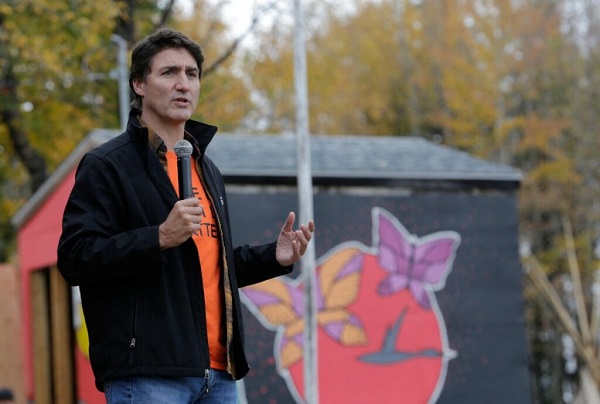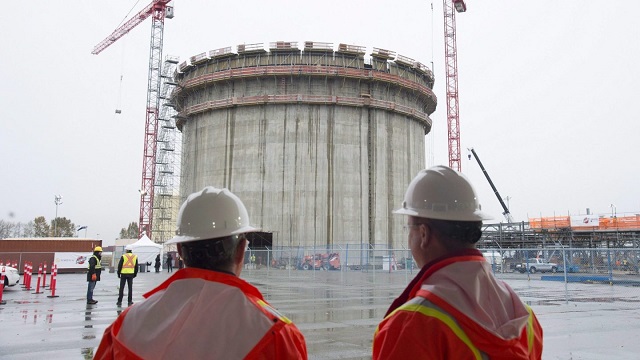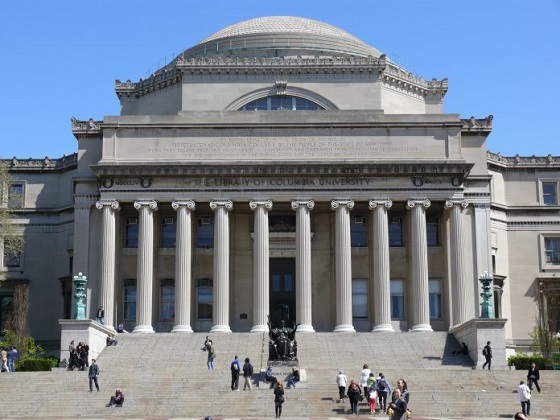Energy
Canada’s Indigenous Peoples Eye Big Energy Deals, Await Trudeau Loan Promise

From EnergyNow.ca
By Rod Nickel, Nivedita Balu, and Alistair Bell
Trudeau’s government will release its budget April 16 and has said it will include plans to guarantee loans for Indigenous communities investing in major resource projects.
Canada’s First Nations are eyeing their biggest opportunities yet to invest in multi-billion-dollar energy projects from pipelines to power lines, hinging on Prime Minister Justin Trudeau keeping a promise this spring to make the deals easier to finance.
Trudeau’s government will release its budget April 16 and has said it will include plans to guarantee loans for Indigenous communities investing in major resource projects.
The government, which is trying to cut greenhouse gas emissions, has not said whether oil and gas projects will be included but if they are then they would represent some of the biggest Indigenous investment opportunities, from the government-owned Trans Mountain oil pipeline to TC Energy’s Coastal GasLink pipeline.
At least 38 Canadian energy projects were announced with Indigenous investment between 2022 and 2024, ranging in value from C$13 million to C$14.5 billion ($10.69 billion), according to the Fasken law firm, which has worked on some of the projects.
Enbridge is willing to sell Indigenous stakes in all types of assets, including North America’s biggest oil pipeline network, the Mainline, said executive vice-president of liquids Colin Gruending, adding that a Mainline deal would be complex because it crosses the Canada-U.S. border.
“Being open to all forms of energy, I think that’s important,” Gruending said of the federal guarantee. “If we’re going to involve more nations quicker, we need to open it up.”
The federal government will update next steps for a loan guarantee program in its budget, said Katherine Cuplinskas, spokesperson for the finance minister. She did not answer questions about the program’s dollar value or whether it would include oil and gas projects.
For energy companies, Indigenous partnerships provide capital infusions and a way to speed projects through approval from provincial governments that in some cases require First Nations equity.
A federal loan guarantee would allow First Nations to borrow at favorable rates, enabling them to profit, said Niilo Edwards, CEO of First Nations Major Projects Coalition, an Indigenous-owned organization that is advising First Nations on 17 projects worth a combined C$40 billion.
“A lot of (First Nations) are presented major investment opportunities that may be in the hundreds of millions of dollars and just don’t have the capital themselves,” Edwards said.
Alberta, Saskatchewan and Ontario offer provincial guarantees and British Columbia is developing one.
Banks already profit from advising and lending to First Nations and energy companies on deals but are eager for a federal guarantee to free up capital on a bigger scale.
“Provincial/federal loan guarantee programs with clear parameters could create a powerful force for accelerating capital into Indigenous-led projects,” said Michael Bonner, head of Canadian business banking at Bank of Montreal.
Many recent First Nations resource deals involve electricity and renewable energy.
BC Hydro is talking with an Indigenous coalition about buying 50% of its northwest transmission line expansion.
Wind and solar deals are also happening, such as Greenwood Sustainable Infrastructure’s C$200-million solar farm in Saskatchewan, announced in January, which will be at least 10% owned by Ocean Man First Nation.
Spain-based EDP Renewables, which built an Ontario wind farm in 2021 with 50.01% ownership by Piwakanagan First Nation, has multiple Canadian projects under development and is looking for more.
With First Nations knowledge and support, projects advance faster, said EDP North American CEO Sandhya Ganapathy. “Canada is super-high on our radar.”
(Reporting by Rod Nickel in Winnipeg, Manitoba and Nivedita Balu in Toronto Editing by Alistair Bell)
Alberta
Official statement from Premier Danielle Smith and Energy Minister Brian Jean on the start-up of the Trans Mountain Pipeline

Canadian Energy Centre
North America LNG project cost competitiveness

Construction workers look on at the FortisBC Tilbury LNG expansion project in Delta, B.C., Monday, Nov. 16, 2015. CP Images photo
From the Canadian Energy Centre
Lower costs for natural gas, shipping and liquefaction give Canada an edge in the emerging global LNG market
Worldwide concerns about energy security have put a renewed focus on the international liquefied natural gas (LNG) industry. The global demand for LNG is expected to increase over the next few decades.
Global demand growth will be driven primarily by Asian markets where the need for LNG is expected to increase from 277 million tonnes (MT) in 2025 to 509 MT by 2050 (see Figure 1). By 2050 the demand for LNG in Europe will be 83 MT and in Africa 20 MT. In South America too, demand will increase – from 13 MT in 2025 to 31 MT in 2050.

Source: Derived from Rystad Energy, Gas and LNG Markets Solution.
In North America (Canada, Mexico, and United States) a number of LNG projects that are either under construction or in the planning stages will benefit from the rise in global LNG demand.
North American LNG production is expected to grow from 112 MT in 2025 to over 255 MT by 2050 (see Figure 2). In Canada, the LNG projects under construction or in the planning stages include LNG Canada Phases 1 & 2, Woodfibre LNG, Cedar LNG, the Tilbury LNG expansion, and Ksi Lisims LNG. Canada’s LNG production is expected to grow from just 2 MT in 2025 to over 43 MT by 2050. In the United States production is projected to increase from 108 MT in 2025 to 210 MT in 2050.

Source: Derived from Rystad Energy, Gas and LNG Markets Solution.
This CEC Fact Sheet uses Rystad Energy’s Gas and LNG Markets Solution¹ to benchmark the cost competitiveness of LNG projects that are under construction and proposed in Canada compared to other LNG projects under construction and planned elsewhere in North America. (Note that the content of this report does not represent the views of Rystad Energy.)
The LNG cost competitiveness benchmarking analysis used the following performance metrics:
- LNG plant free-on-board (FOB) cost break-even;
- Total LNG plant cost (for delivery into Asia and Europe).
The objective of this LNG cost competitiveness benchmarking is to compare the competitiveness of Canadian LNG projects against those of major competitors in the United States and Mexico. The selection of other North American LNG facilities for the benchmark comparison with Canadian LNG projects (LNG Canada, the Tilbury LNG Expansion, Woodfibre LNG, Cedar LNG, and Ksi Lisims LNG) is based on the rationale that virtually all Canadian LNG plants are under construction or in the planning stage and that they compare well with other North American LNG plants that are also under construction or are being planned between 2023 and 2050. Further, to assess the cost competitiveness of the various LNG projects more accurately, we chose only North American LNG facilities with sufficient economic data to enable such a comparison. We compared the cost competitiveness of LNG coming from these other North American projects with LNG coming from Canada that is intended to be delivered to markets in Asia and Europe.
1. Rystad Energy is an independent energy research company providing data, analytics, and consultancy services to clients around the globe. Its Gas and LNG Markets Solution provides an overview of LNG markets worldwide. The Solution covers the entire value chain associated with gas and LNG production, country and sector-level demand, and LNG trade flows, infrastructure, economics, costs, and contracts through 2050. It allows for the evaluation of the entire LNG market infrastructure, including future planned projects, as well as the benchmarking of costs for LNG projects (Rystad Energy, 2024).
Comparison of LNG project FOB cost break-even (full cycle)
Figure 3 provides a comparison of the free-on-board (FOB) cost break-even for LNG facilities under construction or being planned in North America. FOB break-even costs include upstream and midstream costs for LNG excluding transportation costs (shipping) as seen from the current year. Break-even prices assume a discount rate of 10 percent and represent the point at which the net present value for an LNG project over a 20- to 30-year period becomes positive, including the payment of capital and operating costs, inclusive of taxes.
Among the selected group of North American LNG projects are Canadian LNG projects with an FOB break-even at the lower end of the range (US$7.18 per thousand cubic feet (kcf)) to those at the higher end (US$8.64 per thousand cubic feet (kcf)).
LNG projects in the United States tend to settle in the middle of the pack, with FOB break-even between US$6.44 per kcf and US$8.37 per kcf.
Mexico LNG projects have the widest variation in costs among the selected group of projects, ranging from US$6.94 per kcf to US$9.44 per kcf (see Figure 3).

Source: Derived from Rystad Energy, Gas and LNG Markets Solution.
Total costs by project for LNG delivery to Asia and Europe
The total cost by LNG plant includes FOB cost break-even, transportation costs, and the regasification tariff. Figure 4 compares total project costs for LNG destined for Asia from selected North American LNG facilities.
Canadian LNG projects are very cost competitive, and those with Asia as their intended market tend to cluster at the lower end of the scale. The costs vary by project, but range between US$8.10 per kcf and US$9.56 per kcf, making Canadian LNG projects among the lowest cost projects in North America.
The costs for Mexico’s LNG projects with Asia as the intended destination for their product tend to cluster in the middle of the pack. Costs among U.S. LNG facilities that plan to send their product to Asia tend to sit at the higher end of the scale, at between US$8.90 and US$10.80 per kcf.

Source: Derived from Rystad Energy, Gas and LNG Markets Solution.
Figure 5 compares total project costs for LNG to be delivered to Europe from select North American LNG facilities.
Costs from U.S. LNG facilities show the widest variation for this market at between US$7.48 per kcf and US$9.42 per kcf, but the majority of U.S. LNG facilities tend to cluster at the lower end of the cost scale, between US$7.48 per kcf and US$8.61 per kcf (see Figure 5).
Canadian projects that intend to deliver LNG to Europe show a variety of costs that tend to cluster at the middle to higher end of the spectrum, ranging from US$9.60 per kcf to and US$11.06 per kcf.
The costs of Mexico’s projects that are aimed at delivering LNG to Europe tend to cluster in the middle of the spectrum (US$9.11 per kcf to US$10.61 per kcf).

Source: Derived from Rystad Energy, Gas and LNG Markets Solution.
Conclusion
LNG markets are complex. Each project is unique and presents its own challenges. The future of Canadian LNG projects depends upon the overall demand and supply in the global LNG market. As the demand for LNG increases in the next decades, the world will be searching for energy security.
The lower liquefaction and shipping costs coupled with the lower cost of the natural gas itself in Western Canada translate into lower prices for Canadian LNG, particularly that destined for Asian markets. Those advantages will help make Canadian LNG very competitive and attractive to markets worldwide.
-

 Uncategorized2 days ago
Uncategorized2 days agoMaking Alberta a geothermal energy leader
-

 Alberta2 days ago
Alberta2 days agoThree Calgary massage parlours linked to human trafficking investigation
-

 Alberta2 days ago
Alberta2 days agoAlberta’s vision for passenger rail
-

 Addictions2 days ago
Addictions2 days agoMust Watch: Addiction worker estimates 90% of “safer supply” drugs resold on black market
-

 conflict1 day ago
conflict1 day agoColumbia on Lockdown After pro-Palestinian Protesters Take Over Building, Hold Janitors Hostage
-

 Canadian Energy Centre1 day ago
Canadian Energy Centre1 day agoNorth America LNG project cost competitiveness
-

 Business24 hours ago
Business24 hours agoWEF panelist suggests COVID response accustomed people to the idea of CBDCs
-

 John Stossel2 days ago
John Stossel2 days agoWhy Biden’s Just Wrong: NO ONE “Knows How to Make Government Work.”







